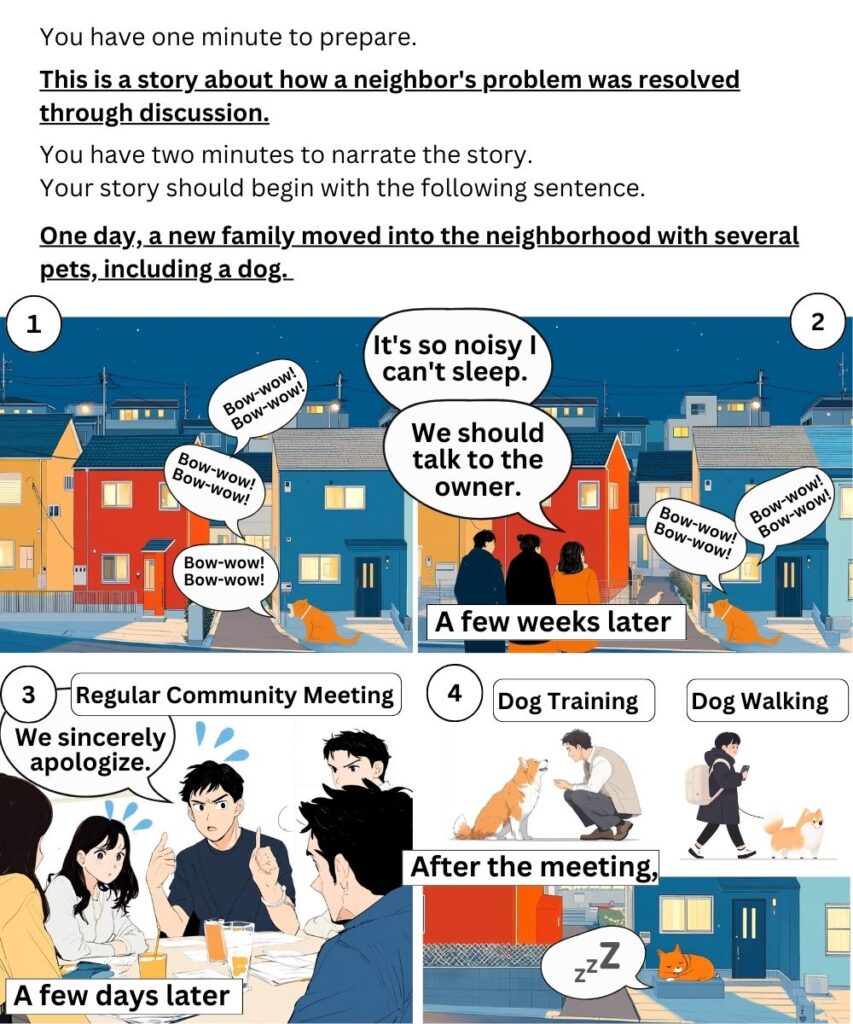実際の出題形式(問題カード)で英検準1級の面接練習を独学できるページです。
2024年度リニューアル対応!
所要時間:概ね8分
目次
- 1 質問概要
- 2 問題カード
- 3 ナレーションと質問
- 4 質問音源チャレンジ
- 5 解答例
- 6 ペット犬ジョーク
- 6.1 1. What kind of dog loves to take a bath? A shampoo-dle!
- 6.2 2. Why did the dog cross the road? To get to the “barking” lot!
- 6.3 3. What do you get when you cross a dog and a calculator? A friend you can count on!
- 6.4 4.英語: Why don’t dogs make good dancers? Because they have two left feet!
- 6.5 5. Why did the dog bring a pencil to the vet? Because it wanted to draw some attention!
- 6.6 6. What’s a dog’s favorite instrument? The trom-bone!
質問概要
ナレーション内容を考える(1分間)
イラストの内容を説明するナレーションを考える
ナレーション(2分間):ナレーションを始める
※2分以上続く場合は、途中でも中止させられるので注意
Q&A(No. 1):イラスト関連の質問
イラストに関連した質問。「問題カード」を見ながら解答できます。
※登場人物が考えている事などを聞かれます。
Q&A(No.2, No. 3)
問題カードに関連した、受験者の意見を問う質問
Q&A(No. 4)
問題カードのトピックに少し関係のある質問。受験者の意見を問う質問
※この<No. 4>質問文に「導入文」が追加されました。
問題カード

ナレーションと質問
ナレーション指示
<指示>Look at the pictures carefully and read the directions silently for one minute.(1分間)
<指示>Now, please begin your narration.(2分間)
Question No.1
Please look at the second picture. If you were one of the residents, what would you be thinking?
Question No.2
Do you think that talking to neighbors directly is the best way to resolve issues like noise disturbances?
Question No. 3
Do you think noise pollution is becoming a bigger problem in urban areas?
Question No.4
In many neighborhoods, community meetings are held to address common concerns. Do you think community meetings are effective in solving neighborhood issues?
質問音源チャレンジ
本番のように、英語の質問を聞いて答える練習をしてみましょう。
ナレーション準備
ナレーション開始
Question 1 mp3
Question 2 mp3
Question 3 mp3
Question 4 mp3
解答例
ナレーション例
<1> One day, a new family moved into the neighborhood with several pets, including a dog. The dog often barked loudly, disturbing the neighbors, especially at night.
ある日、新しい家族が犬を含む複数のペットと共に近所に引っ越してきた。犬はよく吠え、特に夜中に近所の住民たちを悩ませていた。
1枚目のイラストはシンプルな状況描写だけやね。
イラストごとに、だいたい同じ量のナレーションが理想的やけど、今回は、イラストごとにナレーションの長さを変える(トータル時間は2分)タイプを紹介するよ。
<2> A few weeks later, one of the neighbors said that he couldn’t sleep because of the noise. The other resident suggested they talk to the dog’s owner.
数週間後、近所の住民の一人が、「うるさくて眠れない」と訴えた。もう一人の住民が「飼い主に話してみよう」と提案した。
2枚目も、比較的ナレーション量は少なくてOKやね。
3枚目・4枚目の内容が濃いので、1枚目・2枚目のナレーションは少なめにしているよ。
<3> A few days later, the concerned neighbors attended a regular community meeting. During the meeting, they brought up the issue of the noisy dog. The new family sincerely apologized, explaining that they were not aware of how much the barking was bothering others.
数日後、心配していた住民たちは定例の地域会議に参加し、そこでこの問題を提起した。新しい家族は心から謝罪し、吠え声が他人にどれだけ迷惑をかけているか気づいていなかったと説明した。
「bring up = 話題を持ち出す」
1. raise: 問題や話題を「提起する」
2. mention: 「言及する」という軽いニュアンスで、話題をさりげなく出すときに使う
3. touch on: 話題に「触れる」という意味で、深く掘り下げずに軽く話題に上げる場合に使う
4. bring into discussion: 話題を議論の対象にするという意味
5. introduce: 話題や問題を新しく「紹介する」「持ち出す」という意味
6. bring to attention: 特定の問題や話題に注意を引くために持ち出す
<4> After the meeting, the family decided to take action. They began training their dog to be quieter and also made sure to walk it regularly to burn off excess energy. The efforts paid off, and soon the dog became much calmer and quieter. As a result, the neighborhood became peaceful again, and the neighbors could sleep soundly at night, feeling relieved that the problem was resolved through discussion and understanding.
会議の後、その家族は対策を講じることにした。犬を静かにするための訓練を始め、エネルギーを発散させるために定期的に散歩をさせた。その努力は実を結び、犬は次第に落ち着いて静かになった。その結果、近所は再び平和を取り戻し、住民たちは問題が話し合いと理解を通じて解決されたことに安堵しながら、夜に安眠することができた。
Question 1 解答例
質問:2枚目の写真を見てください。あなたが居住者の一人だったら、何を考えますか?
If I were one of the residents, I would be frustrated by the noise and worried about the impact on my sleep. I might also be thinking about how to address the issue politely with the new neighbors, hoping they would understand and take action to reduce the noise.
もし私が住民の一人だったら、騒音にイライラし、睡眠に与える影響を心配するでしょう。また、新しい隣人にこの問題をどうやって丁寧に対処するかを考え、彼らが理解して騒音を減らすために行動してくれることを願うかもしれません。
「address =対処する, 取り組む」
1. deal with: 問題や状況に「対処する」という意味
2. handle: 問題や状況を「取り扱う」や「処理する」という意味で、具体的な行動を示唆する
3. tackle: 問題に「取り組む」や「立ち向かう」という意味で、積極的に対処するニュアンス
4. approach: 問題や状況に「取り組む」「アプローチする」という意味で、どういう方法で対処するかを考える場合に使う
5. manage: 状況を「管理する」や「うまく処理する」という意味で、問題をうまく制御するニュアンスがある
6. resolve: 問題を「解決する」という意味で、最終的な解決策を見つけるというニュアンス
Question 2 解答例
隣人と直接話すことが、騒音障害などの問題を解決する最善の方法だと思いますか?
Yes. Talking directly to neighbors allows for open communication and helps both parties understand each other’s concerns, which is essential for resolving issues amicably.
はい。直接隣人と話すことで、双方が互いの懸念を理解しやすくなり、友好的に問題を解決するためには重要です。
No. Directly addressing the issue with neighbors can sometimes lead to tension or conflict. It might be better to involve a neutral third party, like a community mediator, to help resolve the issue.
いいえ。隣人に直接問題を伝えると、時には緊張や対立が生じることがあります。中立な第三者、例えばコミュニティの調停者などを介入させて問題を解決する方が良いかもしれません。
Question 3 解答例
都市部では、騒音公害が大きな問題になっていると思いますか?
Yes. As urban areas become more densely populated, noise pollution from traffic, construction, and other sources is increasing, making it a significant issue for residents.
はい。都市部がますます人口密度が高くなるにつれて、交通や建設などからの騒音公害が増加し、住民にとって重要な問題となっています。
No. While noise is a concern in some areas, advances in technology, such as better soundproofing and noise-reducing materials, have helped to mitigate the impact of noise pollution in many urban areas.
いいえ。騒音は一部の地域では問題ですが、防音技術や騒音低減材料の進歩により、多くの都市部で騒音公害の影響が軽減されています
Question 4 解答例
多くの地域では、共通の懸念事項に対処するためにコミュニティミーティングが開催されています。地域の問題を解決するために、コミュニティミーティングは効果的だと思いますか?
Yes. Community meetings provide a platform for residents to voice their concerns and collaborate on solutions, fostering a sense of togetherness and mutual support in the neighborhood.
はい。地域の会合は、住民が懸念を表明し、解決策を協力して考える場を提供し、地域の一体感や相互支援の感覚を育むのに役立ちます。
No. Community meetings can sometimes be inefficient or dominated by a few vocal individuals, making it difficult to reach a consensus or find effective solutions.
いいえ。地域の会合は、時には非効率的であったり、一部の声の大きい人々に支配されてしまうことがあり、合意を得たり効果的な解決策を見つけるのが難しくなることがあります。
面接練習はask本校にお尋ねください:無料体験レッスン予約
こちらの投稿もおススメです:英検準1級面接問題カード|在宅勤務トピック質問と回答例
ペット犬ジョーク
1. What kind of dog loves to take a bath? A shampoo-dle!
どんな犬がお風呂が大好き? シャンプードル!
解説: 「shampoo(シャンプー)」と「poodle(プードル)」をかけたダジャレです。プードルが水遊びを好む犬種であることもあり、シャレが効いています。
2. Why did the dog cross the road? To get to the “barking” lot!
なぜ犬は道路を渡ったの?駐車場(barking lot)に行くためさ!
解説: 「parking lot(駐車場)」と「barking(吠える)」をかけた言葉遊びです。駐車場に行く理由を、犬が吠えることに関連づけています。
3. What do you get when you cross a dog and a calculator? A friend you can count on!
犬と計算機を掛け合わせると何ができる?頼れる友達さ!
解説: 「count on」という表現は「頼る」を意味し、計算機が数字を「数える」という意味とかけています。犬が頼りになる友達であることをユーモラスに表現しています。
4.英語: Why don’t dogs make good dancers? Because they have two left feet!
なぜ犬はダンスが下手なの?だって、両方とも左足だからさ!
解説: 「two left feet」は、不器用でダンスが下手なことを表す英語のイディオムです。犬には実際には「左右の足」がありますが、このイディオムを使って面白おかしく言っています。
5. Why did the dog bring a pencil to the vet? Because it wanted to draw some attention!
なぜ犬は鉛筆を獣医に持っていったの?注目を集めたかったからさ!
解説: 「draw attention」は「注目を集める」という意味のイディオムで、鉛筆で「draw(描く)」することとかけています。犬が獣医に注意を引こうとする行動を描いています。
6. What’s a dog’s favorite instrument? The trom-bone!
犬の一番好きな楽器は何?トロンボーンさ!
解説: 「trombone(トロンボーン)」と「bone(骨)」をかけたダジャレです。犬は骨が好きなことが知られており、その特徴を楽器に結びつけています。




